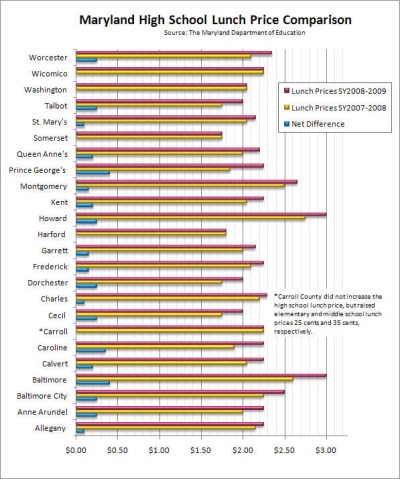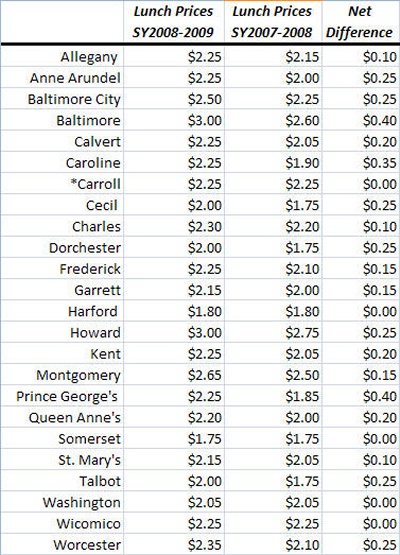WASHINGTON (April 10, 2009) - Maryland's school meal programs are grappling with large financial losses because of increasing food prices, declining meal sales and stagnant federal reimbursement rates, a situation that mirrors the national trend.
"All school lunch programs are going to be having problems—that seems clear," said Dan Townsend, director of food and nutrition services for Prince George's County Public Schools.
Maryland public and non-profit schools participate in the federally funded National School Lunch Program and the School Breakfast Program to provide nutritionally balanced meals to students daily. The programs are administered by the Maryland State Department of Education, which also contributes a small portion of the cost.
Families' economic woes have boosted the need for these programs.
In some counties, more students eligible for free-and-reduced meals are eating "because families are so hard pressed," said Eulalia Muschik, supervisor of food services for Carroll County Public Schools.
With 30 million lunches served daily across the nation, school nutrition programs stand to lose nearly $5 million each school day, according to the School Nutrition Association.
But deficits in Maryland schools can't be totaled until numbers are crunched in July or August.

Almost 75 percent of school districts nationwide increased prices for meals, a la carte or vending goods to make up for increased costs this school year. About two-thirds hiked prices on meals solely to make up lost revenue, according to September 2008 data from the School Nutrition Association.
"It's similar to what people are seeing in the supermarket," said Jodi Risse, registered dietitian and supervisor of food and nutrition services for Anne Arundel County Public Schools. "Prices went up there and also for us."
Of Maryland's 24 school districts, only Harford, Somerset, Washington and Wicomico chose not to increase meal prices this school year.
Prince George's County raised lunch prices from $1.85 to $2.25 for middle and high schools, its first increase in 10 years.
"And let's face it, none of us like it when prices increase," said Townsend.
In 2008, Maryland schools served nearly 100 million breakfasts and lunches through the National School Lunch Program, a number likely to be significantly lower this year, despite growing need for free-and-reduced meals.
"Participation is down overall," said Muschik, who does not expect to break even this year.
Carroll County has the lowest rate of free-and-reduced meal eligibility, as of October 2008, according to the Maryland State Department of Education, but is still feeling the pinch of declining sales.
The county serves about 1,000 fewer meals each day, and lunch prices are about 30 cents higher this year.
"In these tough times, people can't get over it," said Muschik, of customers lamenting the price increase.
Meal participation in Carroll County fell when the new prices were introduced last fall, rose briefly from October through December and decreased again in January and February, which was also when the county's jobless rate rose by more than 2 points to 7.2 percent, Muschik said.
"I can't make people buy when they don't have the money."
On March 4, nutrition and health advocates testified before the Senate Committee on Agriculture, Nutrition and Forestry urging an increase in the federal meal reimbursement, which expires June 30.
Panelist Katie Wilson, president of the School Nutrition Association in Onalaska, Wisc., told the committee that the average cost to produce a meal was $2.92, which is about 35 cents more than the federal reimbursement rate for free meals.
"Congress needs to step up and look at the reimbursement ratio," said Scott Blackburn, food and nutrition services coordinator for Worcester County Public Schools. "It's just not meeting (the need)."
Each year, the National School Lunch Act, which is up for reauthorization this year, automatically increases reimbursement rates to reflect inflation. But that's not enough.

Schools with more than 60 percent student participation receive 26 cents for every paid meal. For free-and-reduced meals the schools get $2.59 and $2.19, respectively.
Those with less than 60 percent participation are reimbursed 2 cents less in all categories. The maximum amount per meal a school can receive is 32 cents for paid, $2.34 for reduced and $2.74 for free.
More than a third of Maryland schools have over 50 percent of students eligible for free or reduced meals, according to October 2008 data from the Maryland State Department of Education.
Students eligible for free lunches come from households earning up to 130 percent of the federal poverty level, or $35,828 for a family of four. Students eligible for reduced lunch pay no more than 40 cents for lunch and have family incomes up to 185 percent of the federal poverty level, or $50,986 for a family of four.
Eligibility has increased in all counties over the past two years, except Allegany and Baltimore City, which showed slight decreases.
The state also contributes some funding based on a fraction of the federal government's reimbursement two school years prior.
In addition, the state education department's School and Community Nutrition Programs will receive a one-time grant of more than $1.2 million for the National School Lunch Program.
The payment, part of the stimulus package passed Feb. 17, will buy new kitchen equipment for needy schools, those with at least 50 percent of the students eligible for free-and-reduced meals.
And funding is still inadequate.
The average cost per meal in Montgomery County is $3.58, but the federal government reimburses free meals at $2.57, according to a school system budget analyst. After a little over a dime from the state, the county is left with almost a $1 deficit per meal.
Anne Arundel saw all food production expenses increase, including labor and supplies. Revenue from a la carte sales, which is down this school year, is used to cover unreimbursed expenses, Risse said, who expects a loss this year.
School systems maintain a fund balance where surpluses from previous years are deposited. They can be tapped when the department runs over budget, but if the balance is low or zero, deficits form.
Frederick County's food service fund balance is almost $2 million in the hole, an amount accumulated over the past 12 years and largely due to the purchase of equipment, said Alfreda Wishard, food service accountant for Frederick County Public Schools.
The school system is "working desperately" to reduce expenses by cutting employee salaries and overtime pay, holding off on building repairs and raising meal prices.
For next school year, there is even talk of furloughs for all Frederick County school system employees and or salary reductions, Wishard said. "We'll probably have to increase (meal) prices again next year."
The state education board increased the budget for Frederick County Public School's Food Service three consecutive school years to help with increased labor and fringe benefit costs. This school year the program received nearly $500,000, which may not be the case next year.
"There's nothing (the school board) can do for us," Wishard said. "It just looks more grim every day."
Caroline County Public Schools doesn't know what it would do in the event of a serious revenue loss, said Ginger Hendricks, food service coordinator of the Child Nutrition Program.
"We're not spending any more money than we can help," said Hendricks, who gets applications for free-and-reduced meals as people lose their jobs. Unemployment in the county jumped to 10.2 percent in February.
"There are things you just cannot cut."
Capital News Service contributed to this report.


